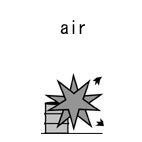| Case Name |
Rupture of high-pressure air piping on the discharge of an air compressor |
| Pictograph |

|
| Date |
October 3, 1983 |
| Place |
Nagoya, Aichi, Japan |
| Location |
Chemical factory |
| Overview |
On October 3rd, 1983. Bend parts of 10 MPa air piping at the air compressor discharge section of an air separation unit exploded. A high temperature of a maximum of 161°C, iron rust in piping, and lubricating oil were the causes. |
| Incident |
In an air separator where liquefaction was carried out for the manufacturing liquefied oxygen, nitrogen, and argon, bend parts of cooling piping for 10 MPa compressed air exploded, four persons nearby were blown off and injured. |
| Processing |
Manufacture |
| Individual Process |
Charge and Feed |
| Process Flow |
Fig3.Unit process flow
|
| Substance |
Air |
| Type of Accident |
Explosion |
| Sequence |
09:10 on October 3rd, 1983. Abnormalities were not found when the pressure of each stage of a compressor was checked during routine operation. Drain was discharged from the oil-water separator.
Around 09:20. Bend parts of an air cooling pipe (diameter: 9 cm) for compressed air of about 10 MPa and 154 °C exploded. Black smoke hung over the area. Related facilities of the compressor were stopped immediately. |
| Cause |
Compressor oil was stained with iron oxide in piping for compressed air. It ignited at the inspection door of the third-stage discharge snubber, and the fire spread. Furthermore, it was speculated that film or soot detonation occurred in the piping.
According to an experiment performed after the accident, heat generation started at 227 °C when fresh oil was used. However, when the oil was stained with mixed powder of alumina and iron oxide and kept at 10 MPa and 164°C, the oil ignited after 11 minutes. Discharge temperature was 154 °C at 9:00 on the day of the accident.
The highest historical temperature was 161°C.
The last inspection of internal washing of discharge lines and the cooler was in 1974. |
| Response |
Operation of air compressor was stopped immediately with an emergency shutdown button. |
| Countermeasures |
Prevention of overheating of discharge air. Prevention of remaining of lubricating oil in piping system. Avoidance of excess supply of oil. |
| Knowledge Comment |
High-pressure air is a powerful oxidizer, and may oxidize the lubricating oil or iron powder. It is necessary to keep high-pressure air piping clean like oxygen piping. |
| Background |
Basic cautions for a high-pressure air compressor were not taken. Both a designer and an operation manager had insufficient knowledge of air compression.
High-pressure air is a very powerful oxidizer, and there are many conditions that have to be fulfilled, for example, selection of lubricating oil, discharge temperature, and cleaning of piping. |
| Incidental Discussion |
Accidents with explosions of high-pressure air have occurred repeatedly for many years. There are many conditions to be fulfilled. For example "the discharge temperature of a air compressor has to be below 140 °C." (Gulf Publishing Co., "What Went Wrong?"). |
| Reason for Adding to DB |
Example of rupture caused due to high-pressure air |
| Scenario |
| Primary Scenario
|
Insufficient Analysis or Research, Insufficient Prior Research, Insufficient Information Transfer, Poor Value Perception, Poor Safety Awareness, Inadequate Risk Recognition, Planning and Design, Poor Planning, Poor Design, Usage, Operation/Use, Poor Cleaning, Bad Event, Chemical Phenomenon, Oxidation Reaction, Secondary Damage, External Damage, Explosion/Rapture, Bodily Harm, Injury, 4 person injured
|
|
| Sources |
The Japan Soc. for Safety Engineering edition. Kogaku Komamiya, Detonation of high-pressure air piping, Accident examples of fires and explosions, pp.207-211 (1985).
|
| Number of Injuries |
4 |
| Physical Damage |
Rupture of third-stage cooling piping. Collapse and deformation of an internal partition plate and nozzles of a third-stage discharge snubber. Damage to electric wiring and instrumentation. 120 slates of factory blew off. Partial destruction of a garage. Exfoliation and scattering of 66 square meters of asphalt pavement. |
| Multimedia Files |
Fig2.Photograph of effects of explosion on piping
|
| Field |
Chemicals and Plants
|
| Author |
ITAGAKI, Haruhiko (Japan National Institute of Occupational Safety and Health)
TAMURA, Masamitsu (Center for Risk Management and Safety Sciences, Yokohama National University)
|